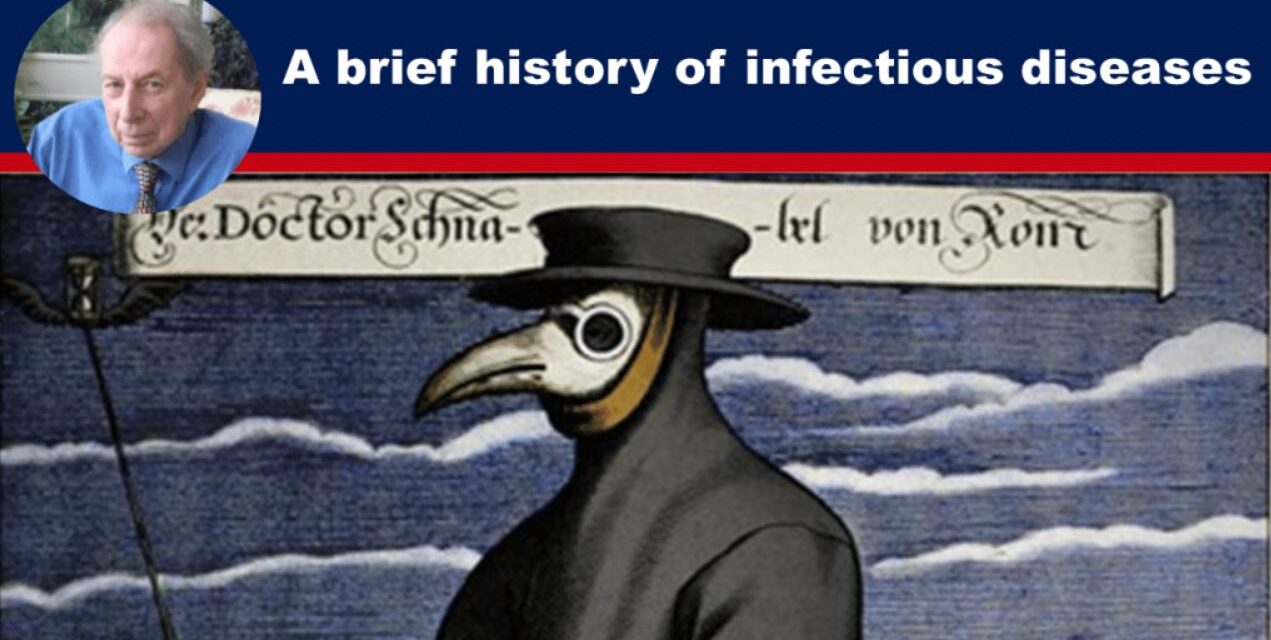In the following, Dr. Vernon Coleman gives a brief history of infectious diseases, beginning in 1541. For unknown reasons, the outbreaks he mentions disappeared. It is unlikely to have had anything to do with medicine or the medical profession, he says.
The Nature of Infection
The following is taken from the book `Medical Heretics: how the medical establishment crushes the truth and suppresses good ideas’ by Vernon Coleman.
During the Renaissance, many attempts were made to explain the precise nature of infectious diseases. The most astonishing attempt was the work of Hieronymus Fracastorio, a Veronese nobleman who, in 1541, published a book entitled ‘De Contagione’.
Fracastorio, whose foresight stands out even among the extraordinary intellectual explosions of the sixteenth century, suggested that contagious diseases were disseminated by small particles of matter which were able to multiply rapidly and which could be spread through the air, by simple, direct contact or from one individual to another through infected clothing.
Fracastorio’s valuable book was virtually ignored at the time because there was no real evidence to support the theory.
It was almost another 150 years before the remarkable microscopist Antonie van Leeuwenhoek described bacteria for the first time. Leeuwenhoek’s day job (or jobs) was as a draper and city hall janitor in Delft. In his spare time, he had ground more than four hundred lenses and built more than two hundred microscopes.
Sadly, neither Fracastorius nor Leeuwenhoek had any impact on death rates and no progress was made in the treatment of infection until the 19th century in England.
Despite their discoveries, epidemics continued to affect Europe, and the mortality rate from infectious diseases was still as great in the seventeenth century as it had been in the less enlightened Middle Ages. The plague hit Italy in 1630 and killed 80,000 in Milan alone. In the Venetian Republic, over half a million are said to have died. In Moscow in 1603, more than 120,000 succumbed, in 1679 Vienna lost 70,000, and in Prague in 1681, 83,000 died.
Throughout the century the plague came and went, affecting France, Italy, Denmark, Germany, Sweden, Switzerland, Spain, the Netherlands and England. Individual attacks of plague were often followed by economic disaster and famine. London was affected in 1624 when 41,000 were killed, in 1635 when another 10,000 died and finally in 1664 when the total number of dead was nearly 70,000.
Europe is still littered with statues and local customs originally created by citizens anxious to give thanks for having avoided the plague. In the English county of Derbyshire, for example, where the villagers of Eyam contracted the plague through a parcel of clothes sent from London, many modern villagers still dress and deck their wells with flowers each year. The wells enabled the individual villages to remain tightly knit, closed communities and therefore helped to prevent the spread of the plague.
Attempts to prevent the plague from spreading and to deal with those suffering from the disease varied from town to town and from country to country. Since no one knew exactly what caused the plague or helped it to spread, attempts to control it were not always devoid of hysteria and superstition. Terrified by this horrible disease, angry mobs would kill any individual thought to have helped spread it.
Colbert, Minister to Louis XIV, issued regulations for the whole of France in 1683 which gave a considerable amount of power to the Board of Health and quarantine station in Marseilles. Houses where people had contracted the plague were burned to the ground. In Milan, a writer who wiped his ink-stained fingers on the walls of houses he passed was stripped, shaved, purged and then tortured. His right hand was cut off, he was stretched on the wheel, his bones were broken and his body was burned. Finally, his ashes were thrown into the river and his belongings were all burnt. A servant girl in Germany who infected herself and her master with the plague by bringing infected property into their home in Königsberg died, but angry, frightened townsfolk ensured that she was exhumed, hanged and then burned at the foot of the gallows.
In the English village of Faversham, the local council appointed three wardens to examine people trying to enter the town and to exclude those who had come from well-known plague areas. A woman was paid to search for dead bodies, which were then buried in lime-filled pits. Infected clothing was burnt in huge fires which were never allowed to go out.
In 1667, Sir William Petty introduced a plan to reduce plagues in London which was based on the far-sighted economic argument for a medical service provided by the State. Petty suggested that the value to society of a healthy individual far exceeded the cost of providing a basic health service to the State and of organising a form of preventive medicine.
Petty was a well-known and respected Renaissance man. Born in 1623, Petty was an English economist and statistician but he also studied medicine at Leyden, Paris and Oxford and worked as a Professor of Music, Professor of Anatomy and Member of Parliament. He argued that sanitary reform and health care could be cost-effective. His status didn’t help much. His suggestions were largely ignored.
In the end, the plague died away not as a result of any human intervention but for reasons of its own. Epidemiologists are still puzzled by the way the disease seemed to disappear from Europe, making one last attack on Marseilles in 1720, when fifty thousand people were killed, and then disappearing until the end of the nineteenth century.
Some historians argue that the plague was transmitted by fleas which lived on the black rat and that it disappeared when the black rat was driven out of Europe by the brown rat, which has a different flea and does not live so close to human beings. Others claim that the black rat was still common in London after the end of the plague. They suggest that the plague was spread directly from man to man and that its demise was due to an acquired immunity which helped to protect the population.
We shall probably never know why the plague finally died away. But whatever the reason, it is unlikely to have had anything to do with medicine or the medical profession. (Nor, incidentally, is there much real support for the popular theory that the Great Fire of London cleansed that city.)
The disappearance of the plague was accompanied by other changes in the incidence of disorders that had previously been endemic in Europe. Leprosy which had at one time affected thousands throughout Europe, had more or less disappeared by the end of the sixteenth century, and syphilis, which had at first decimated the population in some parts of Europe, slowly began to fade in significance.
Other infectious disorders remained rife.
Influenza was common on both sides of the Atlantic, smallpox was seen everywhere, while dysentery and typhoid killed millions.
The death rate among mothers and infants remained high and half the newborn babies in seventeenth century England failed to survive. It was the high mortality rate among infants which kept life expectation figures low.
Much later, drug companies and doctors claimed that it was their work which pushed up life expectation figures. In truth, it was the infant mortality rate which kept average life expectation low. (If one person dies at or around birth and another individual lives to be 100, the average life span is 50 years. If both survive and live to the age of 75, the average life span is 75 years.)
In reality, it wasn’t until Dr. John Snow, the greatest medical hero of modern times, removed the handle from the Broad Street pump and “cured” an outbreak of cholera that the medical profession made any progress in the control of infections.
Note: The above is taken from Vernon Coleman’s book `Medical Heretics: how the medical establishment crushes the truth and suppresses good ideas.’ To purchase a copy, please CLICK HERE.
Source: https://expose-news.com/2025/05/24/a-brief-history-of-infectious-diseases/
Bitchute: https://www.bi,tchut,e.com/channel/YBM3rvf5ydDM/
Telegram: https://t.me/Hopegirl587
EMF Protection Products: www.ftwproject.com
QEG Clean Energy Academy: www.cleanenergyacademy.com
Forbidden Tech Book: www.forbiddentech.website













